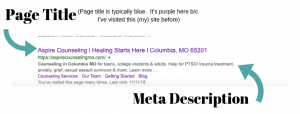How Can Meta Descriptions Help my Counseling Website?
Does either of these situations sound familiar?
- You have a beautiful website that is easy to navigate, has beautiful pictures, and has text written to speak directly to your ideal client. The problem? Nobody can find your site. If you search for counseling in your area or even specify your niche (ex: “help for postpartum depression in Manhattan”) your site doesn’t show up until the 5thor 6th page.
- You’re starting to show up on the first couple pages when someone searches for “Counseling in Chicago, IL.” The problem here? You’ve looked at Google Console and realized that nobody’s actually clicking on your website. Your website still isn’t leading to new counseling clients.

Rewriting Your Meta Descriptions Can Help
The good news is that meta descriptions can help in either one of these situations. If you’re unfamiliar with the term, a “meta description” is the small little snippet of information underneath a website’s title (also called the Meta Title or Page Title) on Google Search results. It’s usually 1-2 sentences about the page. A meta description has two main purposes and therefore helps accomplish two main goals.
Goal #1: Improve your Search Engine Rankings
First, a meta description tells Google what your page is about. It’s like a tiny summary of your page. Therefore, search engines pay attention to what is in a meta description when trying to decide where your page should be listed in the search results. This is the reason we put keywords in a meta description. You can monitor your progress by monitoring how well your mental health website ranks for specific keywords your ideal clients are interested in or simply by looking at the number of “impressions” (times your website showed up in search results) on your Google Console account.
For more information: You can read this blog post for more information on choosing the right counseling keywords to target or this post on monitoring your keyword rankings & SEO progress.
Goal #2: Move People from a Results Page to Your Site
The second job of a meta description is to convince a potential viewer to click on your website. Sometimes I think this is actually the harder to accomplish of the two goals. Therefore, it’s important to carefully craft meta descriptions to encourage potential clients to make the transition. They will go from seeing your site on a list of search results to actually clicking on your page. The percent of clients that do this are measured by the Click Through Rate (CTR). You can find your CTR on you Google Console account. So, if the changes you are making to your meta descriptions are effective at accomplishing this goal, you’ll notice the Click Through Rate increasing.
Both purposes are equally important. It is critical that you show up when someone does a search looking for counseling help. However, it doesn’t do much good to show up if potential clients don’t click on your page. Or, go to your website and learn how you can help.

Are you looking for more guidance on writing the perfect meta descriptions?
Next Step: Begin Writing Quality Meta Descriptions!
So, of course, the next step is to begin writing fabulous meta descriptions! If you’re interested in learning more about how to do this, you can read my 5 Tips for Writing the perfect meta description for your mental health website or sign up for my Free 7 Day E-mail Series that devotes one whole day to this topic.
If you’re struggling to write your own meta descriptions and want some help learning how to implement all of the SEO tips I’ve been writing about OR you’ve just decided you want someone else to do your SEO for you, please reach out today. I’d love to schedule a quick SEO Consultation to see if my services are a good fit for your website.

Meta descriptions are a powerful tool to help your website take off and move up the pages of Google.




Leave a Reply
Want to join the discussion?Feel free to contribute!